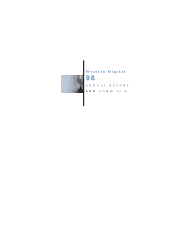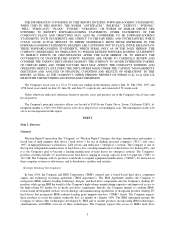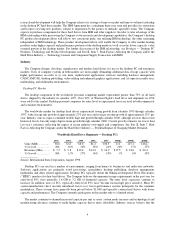Western Digital 1998 Annual Report Download - page 11
Download and view the complete annual report
Please find page 11 of the 1998 Western Digital annual report below. You can navigate through the pages in the report by either clicking on the pages listed below, or by using the keyword search tool below to find specific information within the annual report.
6
on the higher end of the desktop market where capacity per system and performance are most important. The other path
will continue to utilize the Company's own product platforms and technology to design desktop products independently
of IBM technology. These products will be focused on those portions of the market that are most price sensitive,
including the sub-$1,000 PC market. For the majority of the desktop market, which product to produce and sell will be
primarily determined by the overall cost and performance attributes of the hard drive at the particular capacity point as
well as customer product transitions and qualifications.
Enterprise Products
The Company began shipping WD Enterprise products in fiscal 1997. The Company's current enterprise products
offer storage capacities ranging from 2.1 GB to 9.1 GB, are 1.0" high, use the 3.5-inch form factor, feature seek times
of less than 8 msec, and are targeted at workstations, servers, multi-user systems and storage subsystems. WD
Enterprise products utilize the SCSI interface, (both single-ended and low voltage differential) combined with a 7200
rpm spin rate to provide the high performance required to meet the storage needs of enterprise systems.
In order to continue to grow its enterprise business, the Company must expand its product offerings to include the
full range of enterprise products demanded by OEM customers. See "Technology and Product Development." The IBM
Agreement is not applicable to the Company's enterprise business, so enterprise product development must be
achieved through the Company's own technological developments.
Technology and Product Development
Hard drives are used to record, store and retrieve digital data. Their performance attributes are currently better
than removable or floppy disks, optical disk drives and tape, and they are more cost effective than semiconductor
technology. The primary measures of hard drive performance include:
"Storage capacity" — the amount of data that can be stored on the hard drive — commonly expressed in
gigabytes.
"Average seek time" — the time needed to position the heads over a selected track on the disk surface —
commonly expressed in milliseconds.
"Internal data transfer rate" — the rate at which data is transferred to and from the disk — commonly expressed
in megabits per second.
"Spindle rotational speed" — the rotational speed of the disks inside the hard drive — commonly expressed in
revolutions per minute.
All of the Company's hard drive products employ similar technology consisting of one or more rigid disks attached
to a spindle assembly which rotates the disks at a constant speed around a hub. The rate at which the disks spin affects
the drive performance — generally, the faster the disks spin the higher the performance. The disks, or media, are
where the actual data is stored and retrieved. Each disk typically consists of a substrate of finely machined aluminum
or glass on which is deposited a thin layer of magnetic material.
One read/write head is generally associated with each side of each disk and flies just above its surface. The heads
are attached to arms that are linked together to form the head stack assembly. Guided by instructions from the internal
controller, the head stack assembly is pivoted and swung across the disk by a head actuator or motor until it reaches
the selected track of a disk, where the data is recorded or retrieved. The hard drive communicates with the computer
through its internal controller, which controls the drive and interfaces with the host computer. Currently, the primary
interface for desktop PCs is EIDE, and for enterprise systems, SCSI. As performance improves, the hard drive will
need to deliver information faster than these current interfaces can handle. Accordingly, enterprise systems have begun
to incorporate the FC-AL serial interface where very high data transfer rates are important, and the desktop PC
industry plans to transition to high speed serial interfaces such as 1394 to handle the higher data transfer rates. The
Company is working to develop products that will support the FC-AL and 1394 interfaces.
























